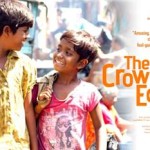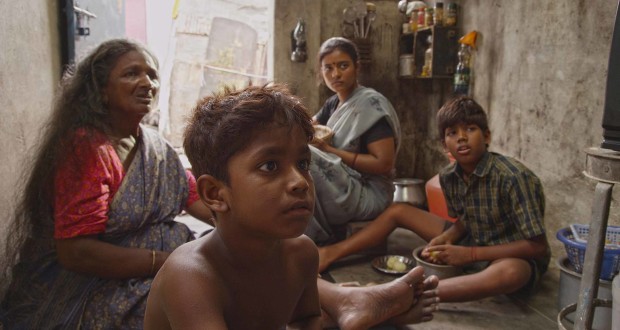The Crow’s Egg shows us a slice of life – literally! – from India today, but that slice has a theme which will be recognised wherever poor people are exploited by the rich. In other words, it is universal. The title is a reference to the plight of the street urchins of India, who often go without food for days and survive by stealing crow’s eggs to eat.
Set in the blistering squalor of a Chennai slum, The Crow’s Egg blends harsh realism with fantasy as it tells the story of two young, impoverished brothers (Kakka Muttai and Chinna Kakka Muttai) who embark on an endeavour to raise enough money in order to be able to enter their local up-market pizza parlour with the desire to taste this new-fangled dish called “pizza”. Realizing that one pizza costs more than their family’s monthly income, they begin to plot ways to earn more money – inadvertently beginning an adventure that will involve the entire city.
The film relies on its young lead actors, V Ramesh and J Vignesh. The boys were joint winners of the Best Actor award at the Indian Film Festival in Los Angeles (IFFLA), where the film also received the Audience Choice Award for Best Narrative Feature.
The Crow’s Egg is a cleverly observed, articulate and excellently narrated Tamil film. It combines realism and satire to explore the issues of extreme poverty, exploitation and the strong power of family values. It mixes bitter sweet emotions with a starkly serious social message and a thought-provoking ending.
[Adverts]
 Director M Manikandan was born in 1982 in a small village in the south of Tamil Nadu. His father was a police officer, which meant that the family moved from one place to another and Manikandan did his schooling in six different places. After high school, he went on to do a Diploma in Automobile Engineering. Realising that it was not his calling, he went on to pursue a career as a wedding photographer. Shifting base to Chennai in 2002, he began his career as an assistant camera operator in feature films.
Director M Manikandan was born in 1982 in a small village in the south of Tamil Nadu. His father was a police officer, which meant that the family moved from one place to another and Manikandan did his schooling in six different places. After high school, he went on to do a Diploma in Automobile Engineering. Realising that it was not his calling, he went on to pursue a career as a wedding photographer. Shifting base to Chennai in 2002, he began his career as an assistant camera operator in feature films.
Manikandan completed a cinematography course in Rajeev Menon’s Mindscreen Film Institute. His career in directing started with Wind (2010), a critically acclaimed fictional short film which was an official selection in many film festivals. He has written and directed The Crow’s Egg, as well as acting as its cinematographer. It was while he was talking to a young boy from the Chennai slums, who told him about the practice of eating crows’ eggs, that Manikandan had the idea for the film. It has developed as an indictment of globalisation. Manikandan believes that by offering us the opportunity to aspire to eat at multinational restaurant outlets and buy internationally known branded products, globalisation is robbing us of our own individual cultures. The film deals with the balance that each society should find – being cautious about their roots while adapting themselves to the global scenario.
The film was shot on location in Chennai, to give it an authentic feel, with minimal film crews, and many of the young actors were originally slum children who had been trained to act naturally in front of the cameras.
[Adverts]
 Here, M Manikandan answers some questions about his life, his career and his film.
Here, M Manikandan answers some questions about his life, his career and his film.
Q: Has film making always been a passion to you?
A: I am from Usilampatti and I have never had any connection to films. After my dad passed away when I was in the 10th grade, there was no one to question me. I pursued a diploma in automobile engineering and started mechanic related work in Chennai, but I got bored of it so I took up still photography. I also had interest in painting, but then I started working as a wedding photographer and gradually became an assistant cinematographer. I worked on two films — Parthiban Kanavu and Sathurangam. Then, I worked with Biju Viswanath for some time.
In 2010, I did a short film called Wind, mainly for my cinematography portfolio. Everyone liked my direction skills better, and my friends started encouraging me to take up direction. It was then that I did another short film — Meendum Oru Punnagai — and that one too was highly appreciated. In fact, Vetri Maaran sir got in touch with me only after seeing that film. It was then that I decided to direct a film. But I had a clear idea of what kind of film I wanted to make and that delayed things a little bit.
Q: Are short-films an easy way of entering the film industry?
A: I’m not sure that short films are a route to making feature films. I’d suggest working in the industry, at least for a couple of years. This is mainly to develop your knowledge and contacts. If some other director had made this film, the budget would have been 40% more. But because I’ve worked in the industry for 14 years, I know the requirement of even the smallest item on the set. That way, I get only what I need and nothing extra.
Q: What was the source of inspiration behind the story of Kakka Muttai?
A: This was a few years ago. Back then, I couldn’t afford Rs 1,000 for a slice of pizza. But I’d anyway buy it because my son wanted it. What got me thinking was why children craved for pizza, but not for fruits or even sweets
At that time, I thought, what if someone who couldn’t afford a pizza wished to have one? I kept thinking about this and started developing it as an idea. To make the conflict stronger, I decided to have the lead characters as slum children. I could only think of kids in the slum who work for daily wages. What if they wanted to taste a pizza? What would they do to satisfy their urge? This inspired me to write this story. I realized that kids get attracted to things only because of catchy advertisements. So, I thought this subject will give me the space to say all these things.
Q: What was the initial reaction when you first pitched the story?
A: I had worked on two scripts earlier and had approached producers then and I knew how they had responded to them. But for this film, I never had the idea of pitching the story to a producer. The idea was to collect funds from friends and shoot it. Many of my friends heard the story. Most told me that the story felt very light. They told me the subject seemed too artistic, was very similar to Slumdog Millionaire, the storyline was thin and that it won’t work at the box office.
I persisted anyway as I know that children’s films generally have a safety net. If you do things correctly and make the kids act well, films usually turn out well. And, screenplays that are based on desires and goals will have a tighter structure because they are plot-driven. Generally, that is how I select scripts. It is not done based on my passion towards the subject or anything, but purely by methodical analysis.
Q: We hear you cast real-life slum kids, was that deliberately done?
A: I initially tested professional child actors but you could see that they were acting — they act in TV serials, so they are trained and that was very visible. That is when I decided that using actual slum kids will be the best method. For one thing, their slang is something you cannot capture with an actor. These boys live by the coastal area and they are so fearless that they dive into the sea from atop rocks. They have so much energy and roam on the streets with an abandon that you cannot find in other kids. I know how much time my son will take to cross the road. But these kids do so in a carefree manner and cross the road in a jiffy.
Q: Was it a great challenge directing these untrained actors, how did you go about it?
A: The problem with these kids was that they did not know how to act in front of a camera, repeat takes or concentrate on the shoot. So, we used different techniques to shoot them. We trained them on how to act without minding the camera, how to maintain continuity, how to not get distracted by comments passed during a shot, how to perform the same shot again and so on. Then, we did rehearsals with them in a real camera set-up. And, we used two cameras during the shoot. That way, they did not have to repeat takes often. As for directing them, even if it was just a scene of them walking, I explained to them what they each should be thinking as they were walking. And I gave different instructions for both the boys. For example, for the same scene, I would be giving different information to the two of them. That way, their reactions to what the other is saying would look natural. I never instructed them together. So, one will not know what the other is thinking or will do. That is why their characters were very distinct in the film.
Q: The film has now succeeded at the box office. How are you ensuring that the kids get a share of the profits?
A: Honestly, I feel we shouldn’t think that the film has become a profit only because of the kids. They are part of the film. We connect the film to them because we have become emotionally connected to them while watching the film. Many people told us that we should educate those kids and we have had to tell them that they are studying in school in real-life and they are street urchins only in the movie.
Even though we shot on a low budget, the producers took quite a risk making the film. They did it because they were passionate about it and no one expected it to become such a big hit. The idea was to recover the cost, if possible. That is why even the promotions were low-key. As for the kids, even before the release, the producers paid them a salary that is three times the amount that is usually paid for child actors; even the kids who appear in supporting characters were all paid the same amount irrespective of their screen time, though the industry practice is to pay supporting characters based on the number of their scenes.
Most people are telling us that now that the film is a hit, we should do something extra for the two heroes. But going by this logic, shouldn’t all the kids who have acted in the film get the benefit? In fact, why not help all slum children? Many have been calling us saying that they want to give the boys gifts or conduct some function for them, but we have been telling them that if you really want to help such kids, please do it for those who are underprivileged in real life. Once the film released, the kids got the National Award. Dhanush sir has announced that he will bear the expenses of their education till they finish college. This, he has announced not just for the two boys but for all the six kids in the film. In addition to this, the studio has come up with a separate plan to ensure their well-being. So, it is wrong to say that the money should go only to the two boys.
Q: What was their reaction when you told them they had won a National Award?
A: They didn’t react to the Award but when I told them that they had to fly to New Delhi to collect the award, they got excited. The only thing they were happy about was that they would get to fly in a plane. The award doesn’t mean a thing to them. It’s only the plane ride that mattered.
•You can see a trailer for The Crow’s Egg on:
https://www.youtube.com/watch?v=yTmR0csh1Z4
The Crow’s Egg was released on 20th November 2015 through Fox Star Studios.
[Adverts]
 East London News A Force for the community…
East London News A Force for the community…




